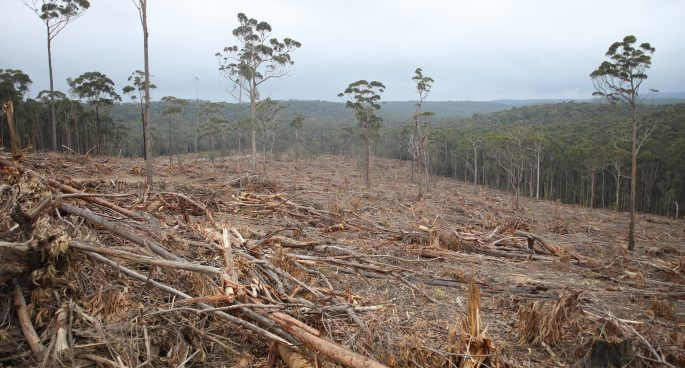Under Threat
DieHappy Forest and the DieHappy Creek catchment area are facing an imminent and existential threat. Astonishingly, NSW Australia still continues the archaic practice of industrial logging of native forests. Having survived countless ice ages, as well as the recent devastating bushfires, the State Government of NSW and the state-owned Forestry Corporation of NSW are, right now, in the final stages of planning the destruction of this jewel of a forest.

Coastal IFOA Native Forest Plan of Operations Map (12 Months) (fcnsw.net)
The Forestry Corporation of NSW is now in the planning phase of the logging of DieHappy Forest. As stated on their website, as of December 2023, logging will commence within 6 to 18 months.
Forestry Corporation of NSW
Forestry Corporation of NSW employs industrial logging practices, utilizing forest harvesters. A harvester is a mechanized and ruthlessly efficient method of harvesting timber from forests. Here’s a description of the process and the destruction it will cause.
Harvester Machinery

A logging harvester is a large, specialized forestry machine equipped with a variety of cutting and processing tools. These machines are designed to fell trees, remove branches, and cut logs to the desired length. The operator controls the harvester from inside a climate-controlled cab, complete with fridge and pie warmer.
Clear-Cutting

In many industrial logging operations, including those planned for DieHappy Forest, clear-cutting is a common practice. This involves the complete removal of all trees within a designated area. The harvester moves systematically through the forest, felling trees and processing them into logs, resulting in a stark and barren landscape.
The few trees remaining in the image above are all that are required for the clear-cutting to be classified as “selective logging”.
Biodiversity
The use of harvesters destroys the habitat of numerous plant and animal species that rely on the forest for survival. The sudden removal of trees and vegetation kills or displaces wildlife.
DieHappy is a vital part of the proposed Great Koala National Park, a last-ditch attempt to save some of the remaining Koala habit left after the devastating forest fires of the 2019/2020 Black Summer.
The DieHappy catchment boasts an abundant and diverse array of wildlife and remarkable biodiversity. Within its boundaries lie old growth sub-tropical rainforests, towering old growth tall eucalypt forests, and notably important threatened ecological communities. This habitat supports numerous endangered species, both flora and fauna, and serves as recognized koala habitat across the entire catchment. It is an area that has astonishing ecological and world heritage values.
Water
Planet Earth is facing a concerning shortage of clean, plentiful water, and the upper Bellinger Valley, home to DieHappy, boasts some of the purest and cleanest water sources. This pristine quality is maintained due to the area not being subjected to clearance or logging.
Logging in this unspoiled catchment will lead to pollution, jeopardizing our water security—a critical issue. Industrial logging not only pollutes our water with sediment but also diminishes the volume of water available in the catchment. When forests are reduced, so is the water they hold.
Forests play a crucial role in water retention and precipitation. They actively generate rainfall through transpiring moisture and releasing particles into the atmosphere. Preserving all our forests intact is imperative for maintaining water security. DieHappy, with its unique beauty, deserves protection from logging activities to safeguard its invaluable contribution to our water resources.
Fire
DieHappy contains important moist forest with areas of pure rainforest and tall eucalypt. Logging these forests would mean they lose their ability to retain their moisture, drying out the remaining forest. This would make it much more fire prone and result in increased intensity of fires, leading to increased risks to lives and property.
The moist forests of the DieHappy valley and catchment are also full of fire-retardant properties which are a strategic advantage when it comes to fire. Currently the proposal to log significant areas of the forest will dry out the catchment by removing the forest and exposing the catchment to desiccation, with wind and sunlight penetrating to the forest floor where previously there was shade.
Logging operations always leave behind a substantial amount of dead biomass. This leftover material, combined with the drying process, heightens the risk of fire, amplifying both its frequency and intensity.
Logging native forest opens up fire-runs, increasing the already growing threat from forest fires. DieHappy and the surrounding forests were some of the few areas to survive the devastating Australia Black Summer bushfires of 2019-2020.
Soil
The slopes of DieHappy are very steep and are composed of rocks and soils that are very prone to landslips, mass movement and erosion. There’s very high rainfall during the wet seasons, the late summer and autumn. To avoid landslips and erosion, it’s extremely important to keep the vegetation intact in the catchment, to not build roads and definitely not log it.
Carbon Emissions
There are really only two ways to stop CO2 emissions globally, stop burning fossil fuels, which represents 85% of annual global emissions, and stop logging native forests, especially old growth forest. In Australia, a third of our CO2 emissions comes from deforestation and degradation of forests. Ending logging of native forests is one of the fastest ways to achieve net zero emissions, and given the cost to Australia’s vulnerable and fragile ecology, and its biodiversity, governments have a moral responsibility to protect these natural assets.